My greetings.
Welcome back to Meta Breaker, the weekly series where I choose a Goliath deck from the Standard meta and build a David deck to take it down. As a refresher, here are the topics I’ll be covering in today’s article:
- Analyzing the current meta and choosing what deck(s) we’d like to target.
- Assessing the strong and weak points of our target(s).
- Identifying cards and strategies that may prove effective against our target(s).
- Building an initial version of our deck and trying it out against the field.
- Continually refining the decklist using observations and statistics taken from test games.
If you’re an extremely astute reader you might notice this list is slightly different from the one from last week’s article - starting today we’re going to be incorporating some more statistics into our refining process! I’ll explain in more detail once I get to that section. But for now, let’s dive right in!
The Enemy
As I discussed last time, the deck you target should satisfy the following conditions:
- It should be a strong deck, i.e. have a high winrate. There’s no point in optimizing your strategy against a weak deck that you would probably beat anyway.
- It should be a deck that’s at least somewhat popular. There’s also very little point in planning your strategy around beating a deck that you almost never face.
Last week’s choice was a pretty easy one, as Aggro Combo Priest is very likely the strongest deck in the meta right now according to most experts. Past that, though, the choice gets a little more tricky as there are a lot of Tier 2 decks of comparable strength floating around in the meta right now. This week we’re going to be taking a look at another strong deck that’s had a bit of a surge since last week thanks to favorable matchups against some other Tier 1/Tier 2 decks.
Fishy Friends
You know them, you love them. The Fishy Friends, the Chummy Chum, the Pesky Pescatarians: it’s Murloc Shaman, of course. Murloc Shaman’s been a pretty consistently strong deck ever since Rise of Shadows, but it’s been on the rise in the past week thanks to good matchups against other strong decks like Combo Priest and Quest Druid. Add on the fact that the deck’s cheap and makes for quick climbing, and you’ve got a deck that you’re pretty likely to run into on the Ranked ladder right now. Here’s the version from our Standard Meta Report.
As I did last week, I played around 20 games with this version to make sure I had a good understanding of the deck. (If you can afford it, it’s a great idea to try playing some games with the deck you’re trying to beat- get inside the mind of your enemy!) Let’s ask some quick questions for a deeper understanding:
How does this deck win?
Murloc Shaman right now is a pretty classic aggro deck. They curve out with their minions, they keep control of the board, and then they burst you down around turn 5-7. What makes Murloc Shaman stronger than your average aggro deck is its resilience. Coldlight Seer and Soul of the Murloc can make early game boards really tough to completely clear. On top of that, if you do manage to clear their board, the deck can generate a ton of extra resources with Underbelly Angler and Fishflinger. And if, Yogg forbid, you ever leave them with a board of 4-5 Murlocs on turn 5, they can just use Bloodlust or their AoE buffing Murlocs to burst you down on the spot. Finally, the Mogu Fleshshaper/Mutate combo is a powerful one-two punch right now in any Shaman deck but is especially strong in this one since it creates very wide boards.
How does this deck lose?
Although Underbelly Angler does help with this, Murloc strategies have always been very all-in. If you can stop their initial assault, the others become much easier to survive. Most of this deck’s plays are much weaker if their turns begin with few or zero Murlocs in play. In addition, their burst relies entirely on buffing their board and going face- they run basically zero removal, so strong Taunts can stop the little fish-men in their tracks. Finally, they run almost no means of direct face damage, so even if they get you very low, you’ll be relatively safe as long as you stabilize and control the board for the rest of the game.
Recipe for Success(ipe)
So here are the criteria that our deck should follow to beat Murloc Shaman:
- Clear out early game boards (this can be with cheap minions or cheap removal)
- Have some way of mitigating Bloodlust burst (this can be with AoE or multiple strong Taunts)
- Take control of the board once it’s stabilized (i.e. you can continually take out whatever threats the Murloc player presents until the game is over)
Brainstorming
Using our recipe to guide our thinking, one point leaps out to me: if you’re going to beat Murloc Shaman, you need AoE and lots of it. It’s not enough to just clear the first wave of Murlocs because they have so many refueling tools. I brainstormed a lot of initial deck ideas and built some control decks with 6 AoE removal spells (mostly Paladin and Warlock), but those board clears were often dead draws against other control decks like Warrior.
Luckily, Saviors of Uldum released a proactive card that’s capable of supplying multiple board clears by itself- Arcane Flakmage.
Looks like Secrets are back on the menu, boys!
The Core
So we know we want to build a deck around Arcane Flakmage, and we want that deck to be good against Murloc Shaman. Well, here are the easy inclusions to start with:
- 2 Arcane Flakmage - Assuming we can protect it, this card fits all three of our criteria. It clears out early boards, can provide additional board clears over the course of the game (thereby mitigating Bloodlust burst) and therefore allows you to maintain control of the board into the late game.
- 2 Ancient Mysteries - The best way to set up an early Flakmage play. Note that when you play this card it often helps to think ahead. You may want to hold on to that 0-cost Secret for a future turn where it either triggers Flakmage or has a more useful effect.
- 2 Flame Ward - Of course we’re going to need Secrets to trigger Flakmage, and this is the obvious choice when you’re facing Murlocs. 3 damage is enough to kill pretty much every threat in their deck- just watch out for Coldlight Seer!
We’ve got a decent start to a core for our deck, but we still could go in almost any direction from here. All we really know is that we want to run some more Secrets. Now generally most Secret decks play a tempo style and try to burst you down before you run out of cards, but that strategy’s not great against Murloc Shaman because they play at a similar pace, but are likely to out-value you. Instead, I’m going to try a different approach. Looking at the other Secrets available to Mage, most of them (besides Flame Ward) seem rather ineffective against a horde of Murlocs.
Taking a look at Splitting Image, I’m going to propose a package that seems fairly effective at holding off the hordes:
- 2 Splitting Image - A powerful defensive tool in combination with the cards below. Often requires careful setup, but has the advantage of being rather uncommon and will often take your opponent by surprise.
- 2 Bone Wraith - A strong turn 4 play to curve after a turn 3 Splitting Image. 2 attack is enough to kill most Murlocs and provides 4 total Taunts if you manage to copy it.
- 2 Khartut Defender - Another strong minion to copy with Splitting Image, and still pretty good on its own. Restoring 6-12 Health to your hero ain’t bad either.
- 1 Zilliax - He slices, he dices, he does your taxes and gives you a nice haircut. Versatile inclusion for any deck, and as a bonus he’s quite good to copy with Splitting Image as well.
How do we win?
Looking at the cards we’ve added so far, it seems like we have a pretty solid game plan:
- Contest the board/clear out threats in the early game
- Gum up the board with taunts, setting up good Splitting Image plays (we have this part pretty much set)
- Maintain control of the board, and have a winning masterstroke play in case the game goes long
Let’s look at how we plan to accomplish these goals.
Contesting the Early Game Board
- 2 Secretkeeper - The best 1-drop available to us, unfortunately. We’re not planning on this snowballing super hard, but it should hopefully get buffed once and trade with 1-2 Murlocs most of the time.
- 2 Belligerent Gnome - Underrated anti-aggro tool in my opinion. Really strong on turn 2-3 and can clear out most of your opponent’s early gameplays.
- 2 Frostbolt - Kills that pesky Underbelly Angler or Murloc Warleader.
- 1 Shooting Star - Pretty useful at most stages of the game against Murloc Shaman, although may be a weak draw in other matchups.
Maintaining Control
- 2 Counterspell - We don’t need to play too many Secrets since Mage’s are a bit expensive. 6 sounds about right, and Counterspell gives you some safety against Bloodlust.
- 1 Masked Contender - A very strong high-value play in Mage since it has the most impactful Secrets. We’re just running 1 because the Secret count in our deck is a little low and it’s not a card we really want to draw two copies of.
- 1 Arcane Keysmith - Solid value on a 4-drop, fills out the curve a little bit. Can get you an extra copy of Flame Ward or Splitting Image, which is nice. It’s a bit low-tempo so we only have 1 copy.
- 1 Blizzard - I wanted to fit in an extra AoE spell to help clear boards when we’re behind, and Blizzard Entertainment fits pretty well. It comes out a turn earlier than Flamestrike, so that’s the one we’ll pick.
Adding our Win Condition
- 2 Power of Creation - The win condition we’re going to try is Khadgar + Power of Creation on turn 10. It should close out the game pretty quickly against most decks, although we may have a hard time if the game goes late against Control. Power of Creation is also pretty decent on its own. Fun fact- now that the Discover card pool chances have been evened out, you now have a (1 - (27/34)*(26/33)*(25/32))% chance to be offered a minion with Taunt, which comes out to around 52%. (That’s counting Hogger as a Taunt minion). This means that this card is actually a pretty reliable tool both offensively and defensively.
- 1 Khadgar - As previously mentioned, Khadgar provides a good way to close out the game. He also already has great synergy with our deck- we can get double Reborn triggers and get 2 copies from Splitting Image!
- 1 Kalecgos - A pretty nice late-game play- can Discover a board clear if we’re in a pinch or just a high-value spell if we’re going late against Control.
- 1 Conjurer's Calling - This is more of a medium value play since we don’t have Giants, but it’s still strong to play this on your Khartut Defender, for instance. Included just the one copy so you have something else to combo with Khadgar in a pinch.
Now we’ve got the first draft of our deck! Let’s see what it looks like.
Testing, Testing, 1-2-3
Last week we discussed the usefulness of evaluating cards and making observations when you’re testing out the first version of your deck, but this week we’re also going to try tracking and integrating some stats into our refining process. There are some great tracking programs that can help you track your results automatically, but I wanted to include some of my own measurements, so I entered my data manually into Excel. Let’s check out some results from 14 games:
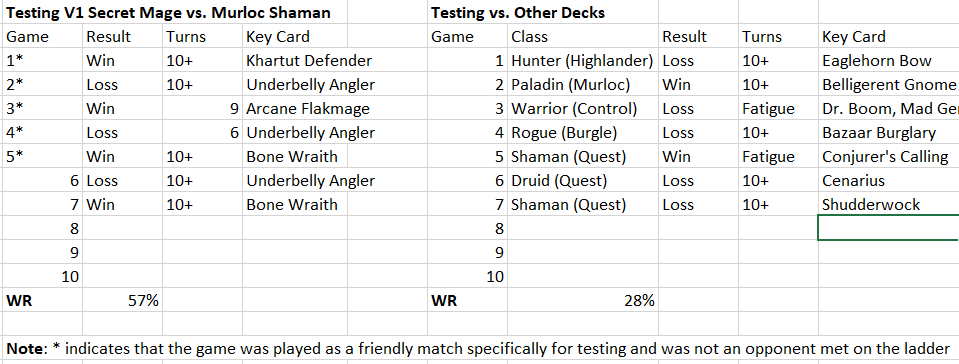
So what are we looking at here? To start, notice how we’ve got 2 columns, one for Public Enemy Number One and another for everyone else. The first thing to point out is that the first five games on the left column were games I played with a friend for the sole purpose of testing the Murloc Shaman matchup. This means that we only actually encountered Murloc Shaman twice out of nine games! That’s definitely not ideal. Does this mean we picked the wrong target? Maybe, but as you can see, we didn't play any other deck more than twice either. Be careful not to draw too many conclusions from small sample sizes.
Secondly, let’s explain why I decided to track each of these statistics:
- Result - Obviously we’re trying to win, so we track how often that happens.
- Turns - This is a simple metric for understanding the flow of the game and generally how our deck is doing. If we’re seeing a lot of losses with low turn numbers, for instance, that would be a clear sign that our deck is getting run over in the early game.
- Key Card - This is a qualitative observation that I make just to get a better sense over many games what cards are proving problematic, and which cards are really getting us our wins. As for the criteria, right after finishing each game I try to mark which card had the highest overall impact. Note that this doesn’t always have to be a finishing card with a huge splashy effect- perhaps it was the turn-1 play that snowballed the entire game, or maybe it was a clutch removal spell on turn 4 that killed a key threat. This is entirely subjective, but I find it useful to keep your focus on the cards that are actually deciding your games.
Evaluating Our Data
Let’s go over some of these stats and figure out what they tell us:
- Results: Versus Murloc Shaman, we have a decent winrate of 57%, which is okay but not fantastic. We’ve also got a disappointing 28% winrate versus the rest of the decks we faced. It seems pretty clear that some changes are in order.
- Turns: Almost every game has gone to at least 10 turns. What we can glean from this is that our deck, at the very least, is consistently surviving the early game, even against aggro decks.
- Key cards: Now here’s where it gets interesting. In our wins versus Murloc Shaman, it seems like the Taunt package is doing good work. Copying a Bone Wraith or Khartut Defender is usually game over in the Murloc matchup, so we know that this portion of the deck is proving effective in this matchup. However, all of our losses to Murloc Shaman have been off the back of Underbelly Angler. In addition, look at the kind of cards we lose to in the right column: Dr. Boom, Mad Genius, Bazaar Burglary, Shudderwock - we tend to get out-valued when the game goes too long. If you look at our decklist, it’s not hard to see why- we’re somewhat lacking in explosive plays and we have basically nothing in the way of card generation.
Now that we’ve taken a look at our data, let’s summarize:
- The Taunt/Secret package seems like quite an effective anti-aggro tool. We are consistently reaching the late game.
- Once we reach the late game, we are significantly lacking in card draw/card generation. Many of the other late-game focused decks will outvalue us in fatigue situations.
- Some specific cards are under-performing (this is more of a personal observation, not necessarily from the data). In particular, Secretkeeper and Masked Contender has been weak in the majority of situations where they are drawn, most likely due to our gameplan and/or low Secret Count.
Ch-ch-ch-changes
Now that we’ve drawn some conclusions from our data, we have a couple of new directions we can take our deck:
- We can double down on removal and try to solidify the Murloc Shaman matchup even more (kill those pesky Anglers!)
- We can figure out a way to make our late-game card generation stronger, preferably without sacrificing too much early-game survivability (I believe this to be the preferred method).
Here are potential changes I might make given the observations from test games:
- -2 Secretkeeper, -1 Masked Contender, -1 Kalecgos, -1 Arcane Keysmith, +2 Mana Cyclone, +1 Magic Trick, +2 Ray of Frost: Mana Cyclone is the most powerful means of card generation available to Mage at the moment. Adding Cyclones would allow us to have some big combo turns in the late game, and give us a better shot at taking down decks like Quest Shaman.
- -2 Power of Creation, -1 Khadgar, -1 Kalecgos, -1 Conjurer's Calling: +2 Cloud Prince, +1 Mirror Entity, +2 Kirin Tor Mage: Doubling down on Secrets and making our deck operate on a faster tempo could also give us a good avenue for beating these slower decks, and keeping the Taunt package should ensure our Murloc Shaman matchup remains strong.
- -2 Secretkeeper, -1 Conjurer's Calling, +1 Flamestrike, +2 Tortollan Pilgrim: Could help us have even more consistent board clears and move us firmly into an anti-Aggro strategy.
Once you’ve made your changes, it’s time to rinse and repeat! Keep on testing, tweaking, and retesting- there’s always room for improvement!
That’s all for this week! What did you think of today’s deck? What decks have you been working on lately to smash the meta? Let us know in the comments, and join me next week to find out if I can write about anything other than Secrets.
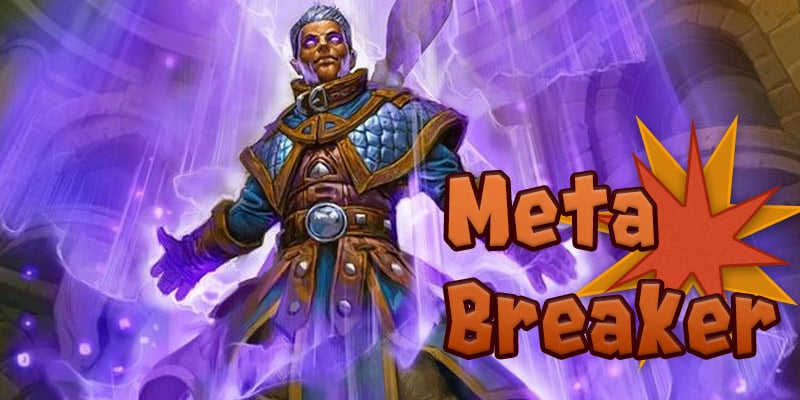
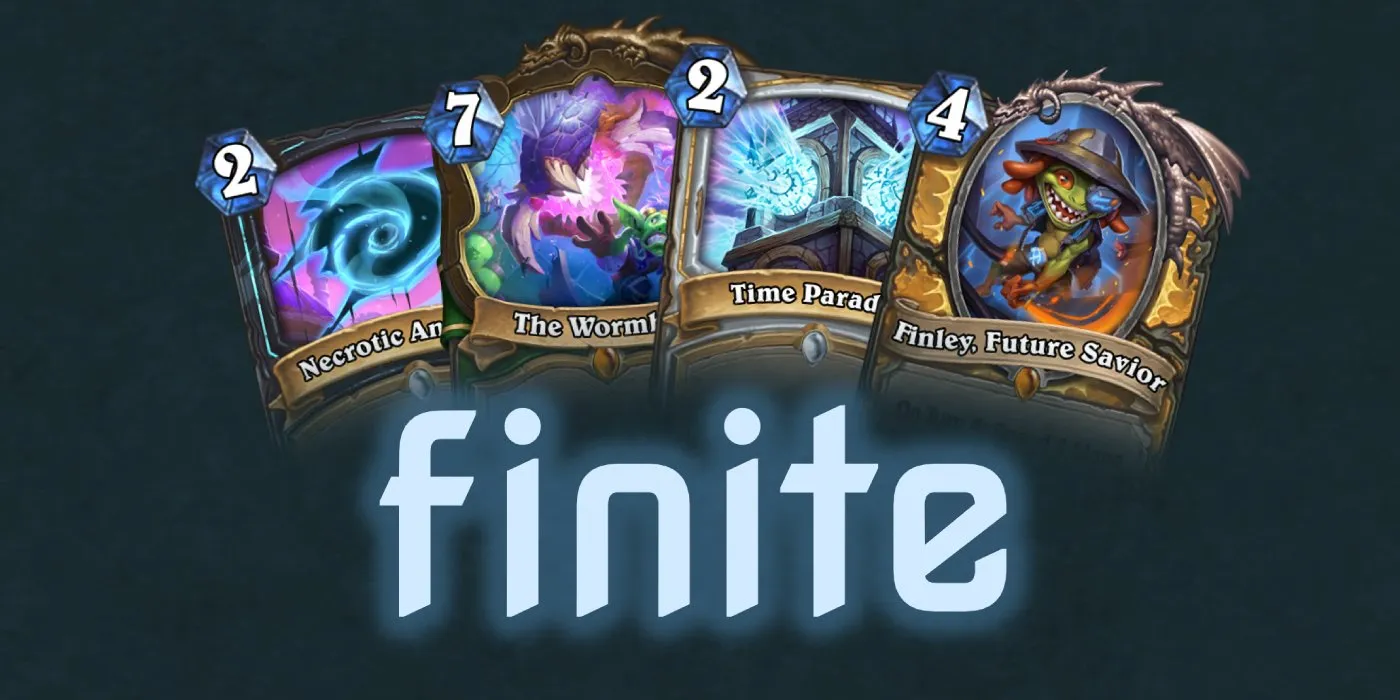
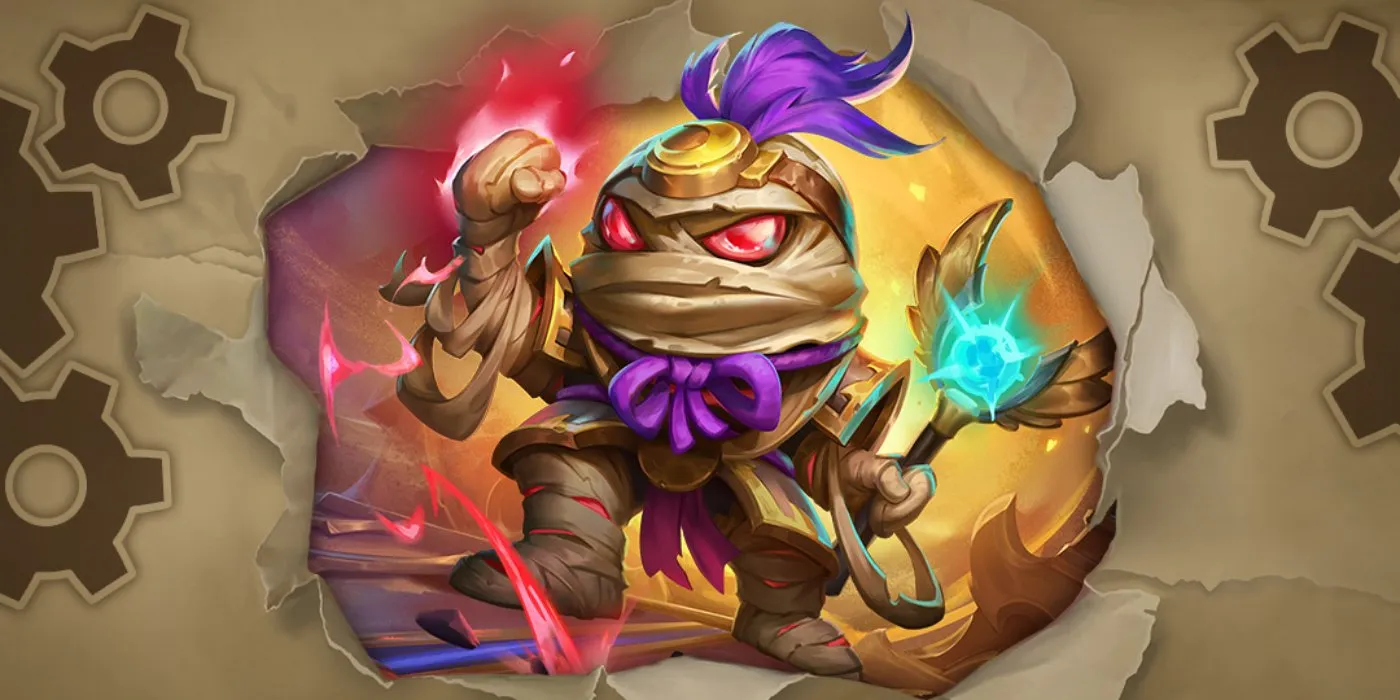
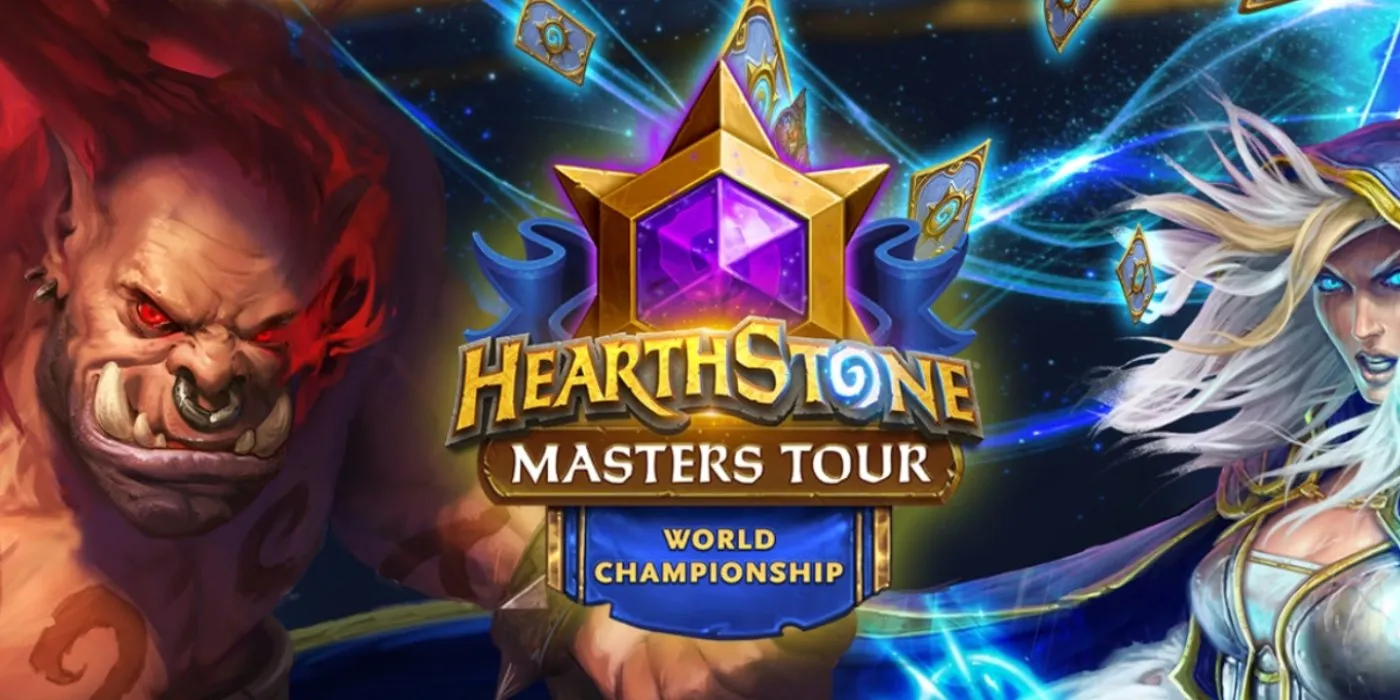
Comments
Very good article. I sometimes kept score in a spreadsheet how the matchups were and what went good and bad, but most of the time I did not analyze it afterwards to make the necessary changes. I just tried another deck if I was getting tired of my current deck. But I see that really analyzing the performance and trying to fix the bad stuff can make a difference. It is easier to blame a result on bad play or bad luck then to really think about the deck itself.
Well written and helped me see thing a lot clearer. Thanks for this!!
Awesome article, FearGralex! I love this series.
Thank you, and thanks for supplying the decklists in the Meta Report for me to steal >:
My $0.02: I think you need to decide to either commit to aggro or control.
If you want aggro: take out everything that costs more than 4 mana except of Zilliax and look for more early board-control options like Magic Dart Frog, [Hearthstone Card (Sorcerer’s Apprentice) Not Found], Spellzerker, Arcane Missiles, Magic Trick, Ray of Frost, a 2nd Shooting Star, and then a couple of Fireballs to close plus Archmage Antonidas as a late-game Hail Mary.
If you want control: then you probably want to look more like a classic freeze mage, with Frost Novas, Doomsayer, Tortollan Pilgrim, etc and focus on stalling the game out until the Murloc deck runs out of gas.
Very good analysis! I will add some thoughts on possible changes:
A little pet-peeve to leave you with: for the love of the god, allign left or right, not left and right! My eyes! :D
Looking forward to the next one ;-)
Thanks for the feedback! I had briefly considered Dune Sculptor, but it makes a lot of sense in this deck over Mana Cyclone - you can just run it out on 3 mana and protect it with Taunts, hopefully gaining incremental value over several turns. Also works well with Ancient Mysteries.
I honestly had no idea about the alignment, so sorry! I write my stuff in Google Docs (where it was all left-aligned) before pasting into the OoC editor, so maybe something happened there. I'll make sure to double-check that from now on!
This is one of the coolest non announcement type articles I have read here. Thank you for such an in depth discussion about taking a deck from idea to build to refinement. Well written.
This is fantastic content!
I love the in-depth walkthrough of the creation and refinement processes.
Inject this into my data-junkie veins. This is seriously top-notch and that excel tracker (particularly the "key card" column) is an idea I will 100% steal.
<Curses!>
<They are onto us now!>
As for the article it's good stuff. I like that it let's you in on the Deck Creation process and the thought pattern that goes with it.
Also it's nice to see a Mage Deck in Standard that isn't Highlander.
I genuinely clicked on the article because I thought that, by looking at the thumbnail, there was some strange Murloc Mage lol.
For the rest, superb work guys
I have a strange Aggro Mage that I used for sometime a few seasons ago. It works well but is super all in, maybe more than Murloc Shaman...
### Aggro MurMage
# Class: Mage
# Format: Standard
# Year of the Dragon
#
# 2x (1) Grimscale Oracle
# 2x (1) Murloc Tidecaller
# 2x (1) Toxfin
# 2x (2) Bluegill Warrior
# 2x (2) Frostbolt
# 2x (2) Hench-Clan Hogsteed
# 2x (2) Murloc Tidehunter
# 2x (3) Arcane Intellect
# 2x (3) Coldlight Seer
# 2x (3) Murloc Warleader
# 2x (3) Nightmare Amalgam
# 1x (3) Stargazer Luna
# 2x (4) Fireball
# 2x (4) Hench-Clan Hag
# 2x (4) Murloc Tastyfin
# 1x (5) Leeroy Jenkins
#
AAECAY0WAq8E7vYCDrsCxQPbA/4DqwSWBeMF0AenCN6CA+KJA7WYA7+YA8edAwA=
#
# To use this deck, copy it to your clipboard and create a new deck in Hearthstone
Well now I know what I'll play on rank 5 for the next few days.
Little advice: isn't Book of Specters better than Arcane Intellect? Your deck has 24 minions, so even a 2 mana "draw 2 discard" 1 is dope since you're aggro and you don't look for value. Moreover, I think that Fishflinger deserves a spot.